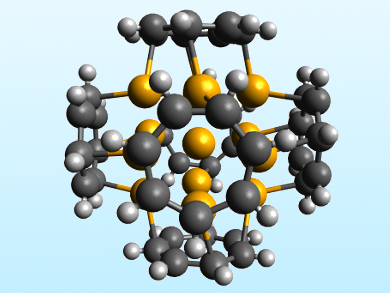Sandwich complexes are well-known organometallic compounds. In a typical sandwich complex, such as ferrocene, a metal atom is bound between two aromatic ligands. Lowering the ratio of ligand molecules to metal atoms can lead to the formation of higher-order, three-dimensional sandwich compounds, for example, [Ni6(C5H5)6] [1]. However, no nanosized three-dimensional sandwich compounds with group 3–10 metals had been reported so far.
Tetsuro Murahashi, Tokyo Institute of Technology, Japan, and colleagues have synthesized three-dimensional sandwich nanocubes with a core of 13 palladium atoms and a shell of six cycloheptatrienyl ligands (pictured). The team reduced [Pd3(μ3-C7H7)2]2+ with a tetraarylborate under neat conditions to give the desired [Pd13(μ4-C7H7)6]2+. The product was characterized using single-crystal X-ray diffraction analysis.
The nanocubes have close-packed cuboctahedral Pd13 cores and octahedral ligand shells. The results show that it is possible to synthesize stable three-dimensional sandwich nanocube compounds containing more than six transition metal atoms. According to the researchers, studying the reactivity and physical properties of such nanocubes could lead to new catalysts and functional materials.
- Three-Dimensional Sandwich Nanocubes Composed of 13-Atom Palladium Core and Hexakis-Carbocycle Shell,
Masahiro Teramoto, Kosuke Iwata, Hiroshige Yamaura, Kenta Kurashima, Koshi Miyazawa, Yuki Kurashige, Koji Yamamoto, Tetsuro Murahashi,
J. Am. Chem. Soc. 2018.
https://doi.org/10.1021/jacs.8b07430
Reference
- Clusterification of reactive species generated through chemical reduction of metallocenes: synthesis and stereochemical characterization of a new hexameric series of metal-cyclopentadienyl clusters, [Ni6(η5-C5H5)6]n (n = 0, + 1),
Michael S. Paquette, Lawrence F. Dahl,
J. Am. Chem. Soc. 1980, 102, 6621–6623.
https://doi.org/10.1021/ja00541a069




